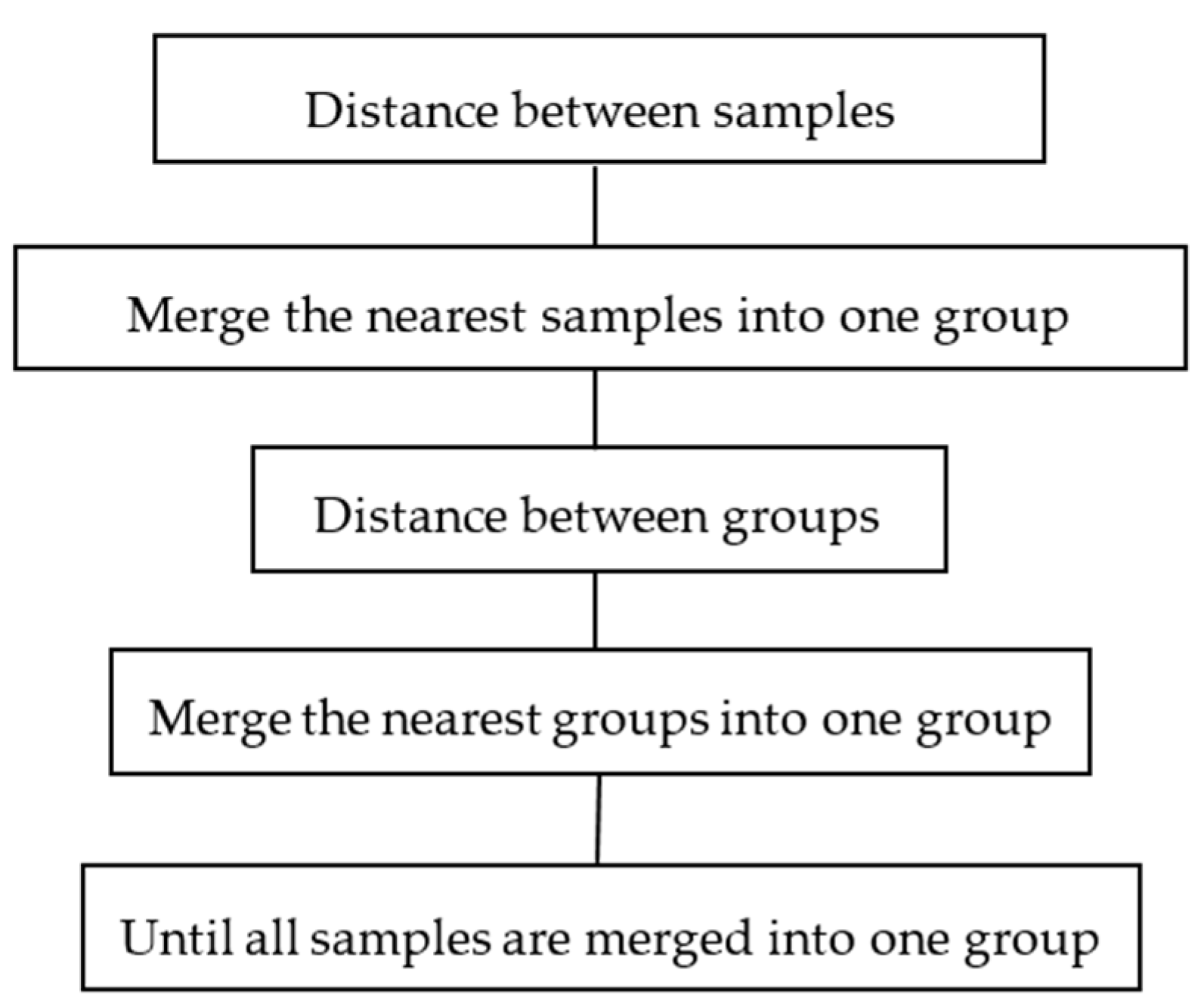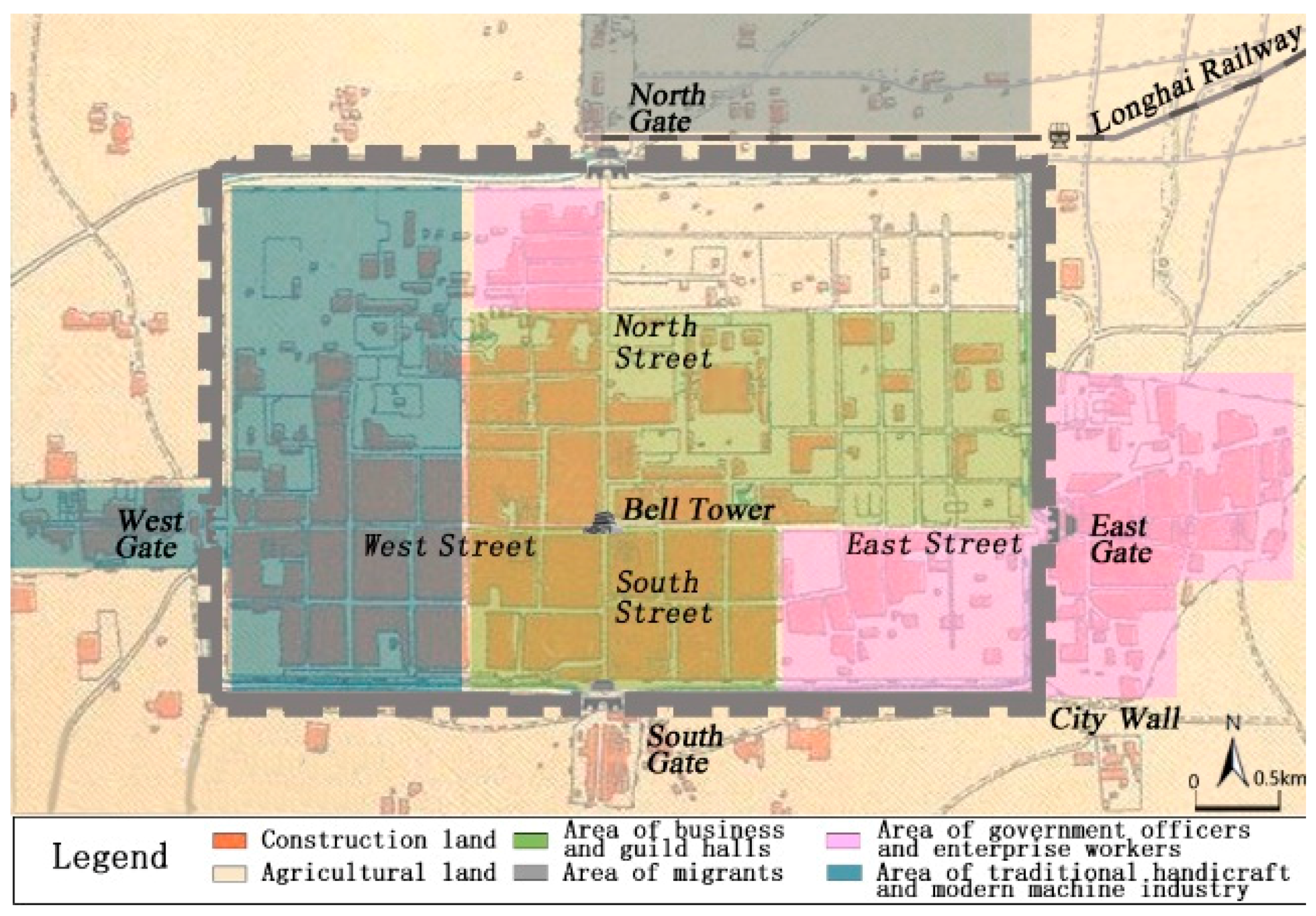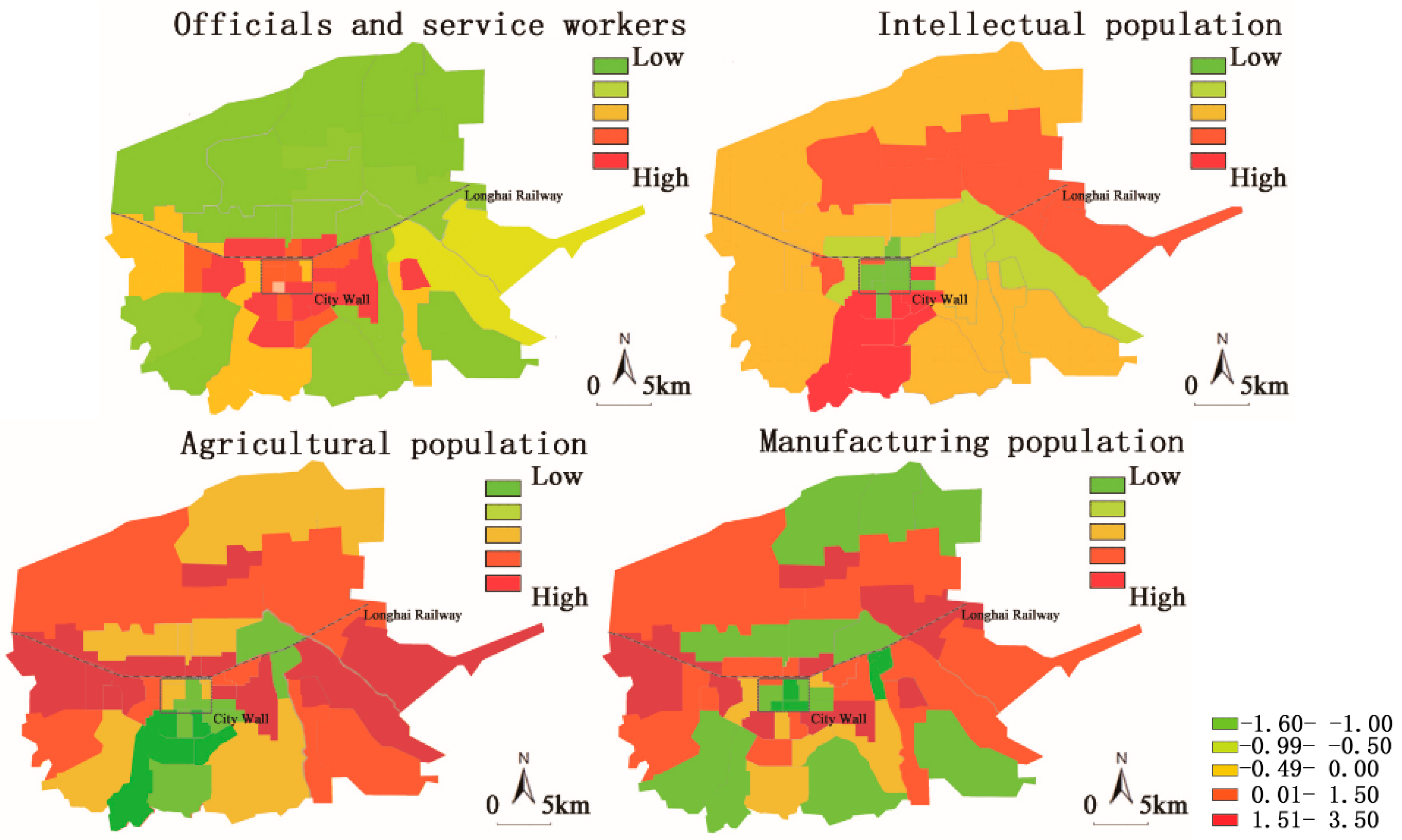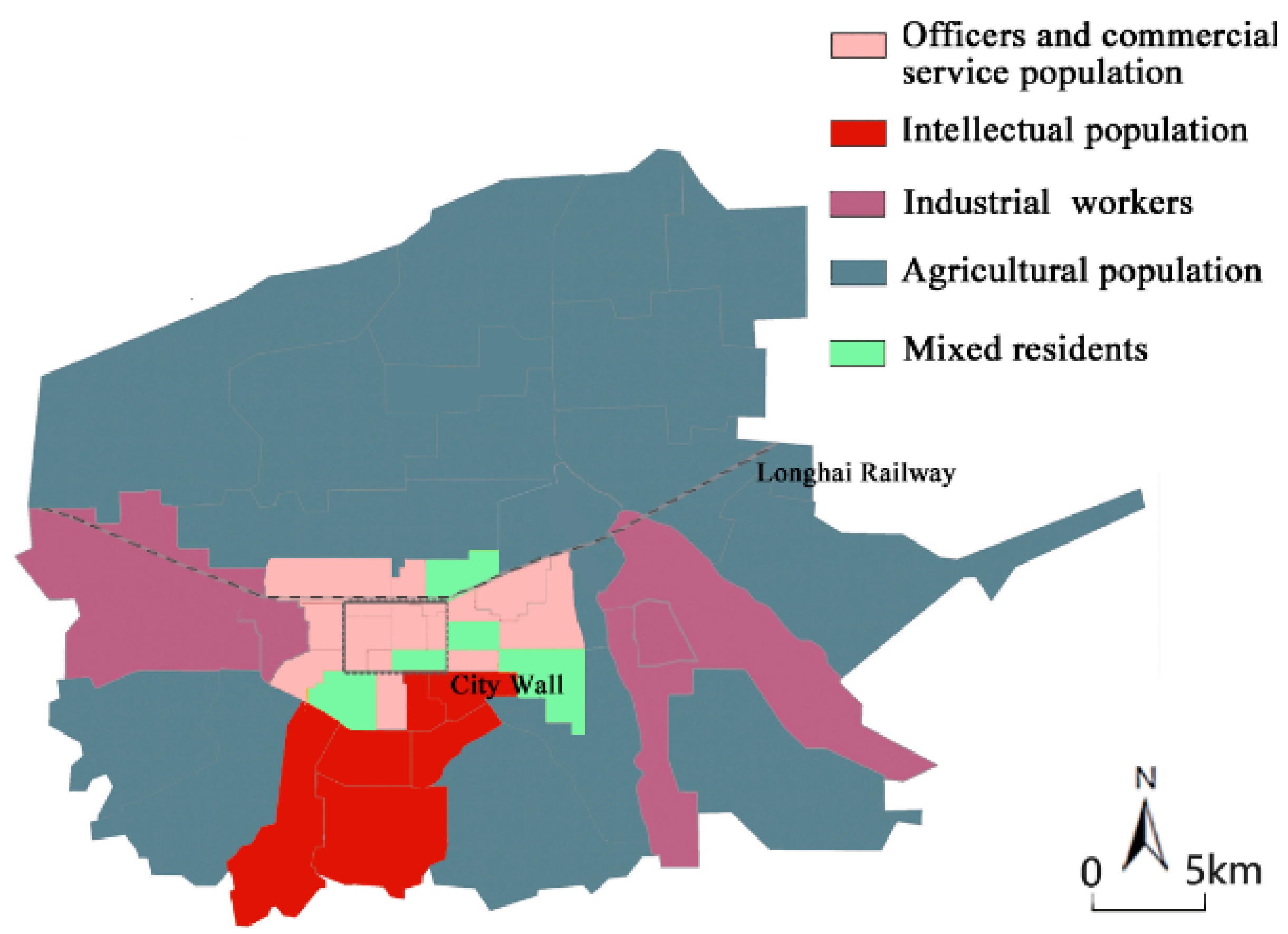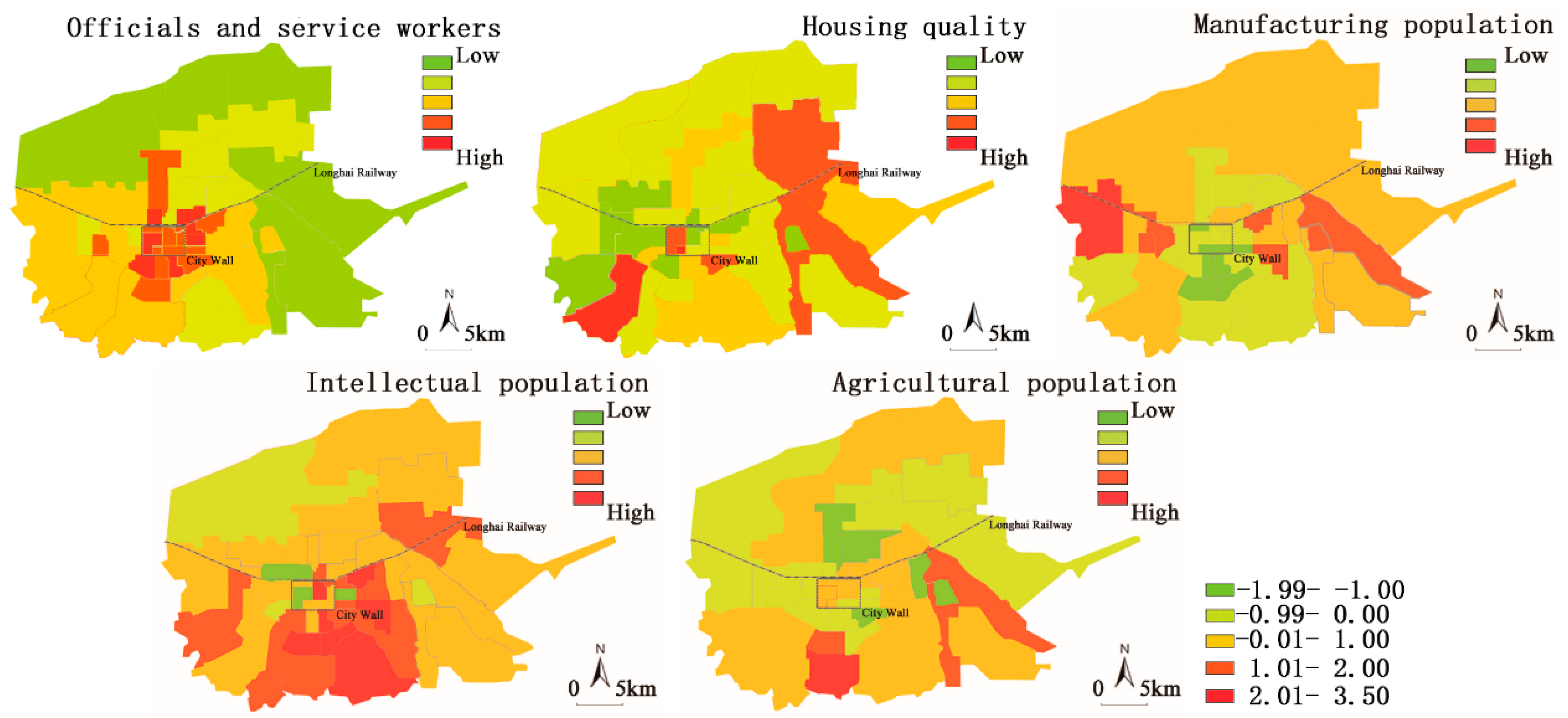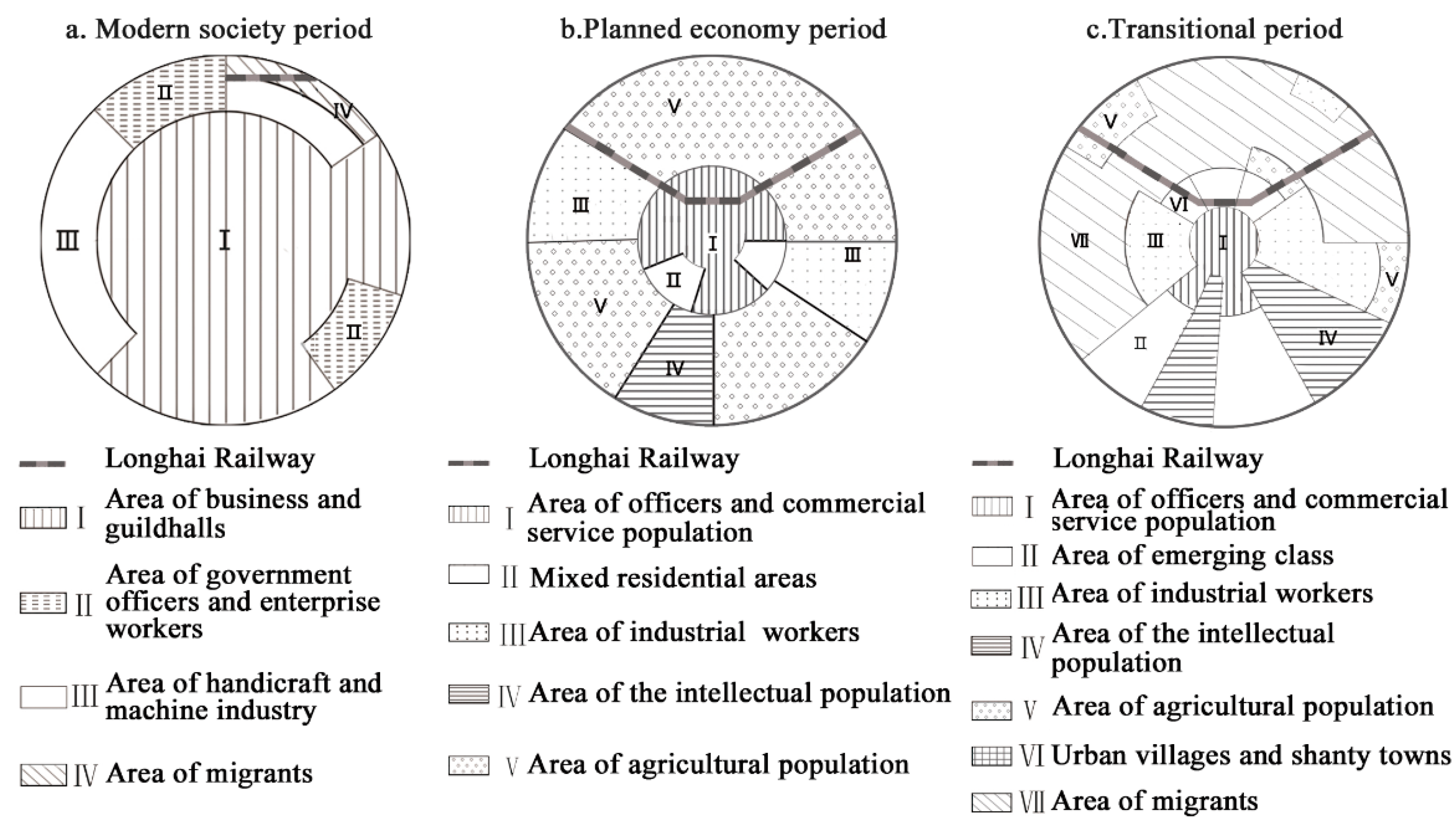1. Introduction
Urban socio-spatial structure is one of the oldest and fundamental research for those who study cities. It is formed by social differentiation related to economic income, social status, lifestyle, consumption patterns and living conditions, and embodies the differentiation and combination of social groups in the geographical space [
1]. It has been resurgent in recent years, and part of this resurgence is due to the development of highly advanced computational techniques, which are being applied to the analysis of massive and complex data. A further reason is the emergence of polarization and the fragmentation of labor, as well as an increasing acceptance of urban forms diversity [
2,
3,
4], which signify the increasing socio-spatial differentiation of urban space [
5]. Research has shown that the socio-spatial structure of a city is closely tied to political, economic and social transformations [
6]. Given the extraordinary growth in Chinese cities and the fundamental shifts in Chinese political economy, China has attracted a substantial attention.
Our study is motivated by two aspects of concerns. Before market reform, households in China enjoyed relatively equal income, housing, education and other forms of social welfare, cities were characterized by mixed social areas based on different land use, rather than social stratification, as workers usually lived in public houses allocated by the state or units [
7]. By that time, China was successful in establishing a classless urban society without significant income inequality among its members [
8,
9,
10]. However, since the beginning of market reform and the open-door policy, the dramatic changes in the Chinese economy has created one of the most dynamic and rapidly expanding urban systems in the world [
11]. Internal urban reforms, the relaxed policy on rural to urban migration, globalization processes, etc. have been shaping the transformation at an unprecedented pace [
12]. Social differentiation is accompanied by enlarged disparities.
More specifically Xi’an, the largest inland city in Northwest China, provides some contrast with some larger and more developed cities in the east, like Beijing, Shanghai or Guangzhou [
13,
14,
15]. Research in these developed cities has demonstrated a different model of socio-spatial structure from Western cities, and proved that socio-spatial differentiation is a feature of Chinese cities that is undergoing dynamic change. As a less developed city, Xi’an has its own characteristics typically associated with rapidly urban development. In addition, empirical case studies published in recent decades focus on the static analysis of a single city or a specific time [
16,
17,
18,
19], little is known about the dynamic evolution process over long periods. In this regard, the objective of this paper lies in two aspects. First, whether these is an identifiable socio-spatial structure to the city of Xi’an, and what are its unique characteristics? Second, how urban socio-spatial structure in Xi’an evolved, as compared to larger Chinese cities in more developed areas?
This paper presents an analysis of socio-spatial structure in Xi’an in different times through the use of historical documents and residential data that have been linked to a spatially rectified map of social space. This study will contribute to understanding social problems and reveal the spatio-temporal process of society’s organization and operation, thereby providing theoretical and practical frameworks for sustainable development.
2. Literature Review
Urban socio-spatial structure first developed into a research topic in geography and related disciplines during the early decades of the 20th century [
20]. Studies in Western countries can be summarized in four stages. Early western scholars, represented by the Chicago School, applied human ecology to the study of residential differentiation and community studies, and proposed the classical urban socio-spatial structure model, such as single core, fan and multi core [
21,
22,
23]. In the 1950s, Shevky put forward “social space” for the first time, and applied it to the urban spatial structure [
24,
25,
26]. The second stage began in 1960s, and it was the stage of accumulation of empirical cases. McElrath’s analysis of Rome showed that the spatial distribution of social economic status and family status were fan shaped and circle stratified, respectively [
27]. Others hold that the main factors of the urban social spatial structure in Seattle are economic status, family status, race and male population [
28]. Empirical studies were concentrated in Western developed countries and regions [
29,
30]. The third stage, which began in 1980s, was the stage of comparison and summary, wherein the scope and depth of case studies continued to expand and attention was paid to the evolution process of urban socio-spatial structure at different times. Hunter used population data of four periods in Chicago and proposed that, while the main factor was still social economic status, the proportion of the family status factor was starting to decline and the proportion of the racial factor was gradually increasing [
31]. Rowland compared the population data of two periods in Moscow, and concluded that ethnic, age, gender and education level were the main factors that lead to the spatial differentiation [
32]. The fourth stage is from the late 1990s to the present, with the trend of diversified development, including the characteristics of urban socio-spatial structure in North America in a Post-Fordist movement [
33], or in African and Latin American countries, a Post-Colonial movement [
34], Post-Easternism in Europe and Post-Socialism in Russia [
35]. In addition, technical methods of urban socio-spatial structure are widely used in social geography, such as racial segregation [
36], urban poverty or crime [
37] and urban gentrification [
38].
Urban socio-spatial differentiation is common across many of the Western countries, with relatively few significant minority groups in the large coastal cities in China, the focus has been on other factors such as tenure [
39], income [
40] and migrant workers [
41]. Researchers have noted that increasing levels of differentiation in the post-reform era results from an imbalance in the distribution of economic returns and social benefits and their spatial consequences during transformations [
42]. Government regulated housing choices through work units and household registration, reforms of housing distribution, land use policy encouraged governments to initiate growth-led neoliberal practices in the housing market, which directly caused significant socio-spatial differentiation [
41]. The relaxed policy on rural to urban migration is also influential in the transformation of urban socio-spatial structure [
43]. Through institutional transition in work units, workers turned into employees and accordingly lost their privileges in housing, welfare or education. This socio-spatial complexity in Chinese cities has pushed researchers to use techniques to find interpretable patterns, such as Guangzhou, which existed as a concentric pattern with the old urban core surrounded by reform housing [
44]. Kunming presents a paradoxical relationship between the rates of neo-liberalist social differentiation and urban restructuring [
11], Nanjing demonstrated a concentric pattern with the lower-profiled social areas encircling the areas of the provincial-government cadre housing, which in turn surrounds the high-status cluster in the city center [
15]. In addition, some culture-based or education-based gentrification of artists or “jiaoyufiers” appeared in inner cities [
45,
46].
Research methods of urban socio-spatial structure first appeared in the school of Human Ecology, where researchers applied the concepts of competition, dominance, symbiosis and invasion in natural ecology to the analysis of urban social space [
47]. On this basis, the Chicago School made a preliminary study of urban community, ethnic agglomeration, urban crime, residential differentiation, and proposed three classical models [
21,
22,
23]. The prosperity of urban socio-spatial structure appeared in 1960s, quantitative factor ecological analysis and hierarchical cluster analysis were carried out. Emergence of philosophical trends, such as positivism, humanism and structuralism, has expanded the research perspective of urban socio-spatial structure [
48]. In 1970s, the Ecology School, Neo Classicism School and Behavior School became the mainstream of the study of urban socio-spatial structure, and then the Neo Marx School and Neo Weber School became the mainstream theory [
49]. Since 1980s, the trend of Cultural Regression had led to the introduction of non-material analysis methods [
50], such as Cultural Value Analysis, Ethical Analysis and Emotional Analysis, into the interpretation of urban socio-spatial structure [
51]. In the late 20th Century, under the influence of humanism, different scholars began to use the method of time geography to study social space. Among all these methods, Factor Ecological Analysis is an effective method for describing the distribution of urban social phenomenon within a regional space [
52]. It uses demographic data, social data and housing indicators in census data to extract main factors that influence the urban socio-spatial structure, and determines social space according to the main factor score cluster, and provides a useful tool for identifying social space. In this paper, we use this method to do research.
The study of the evolutionary mechanisms of urban socio-spatial structure began in 1950s. Three major mechanisms (social and economic status, family status and racial status) are concluded in the study of highly industrialized immigrant cities, such as the United States and Canada [
53,
54]. European cities are less obvious because the unitary national structure, national structure, social and economic status and life cycle are considered the main mechanisms [
55]. Analysis of cities such as Calcutta and Cairo showed that conflict between traditional culture and modern civilization was the greatest influence on evolution [
56], while analysis of Post-Socialist cities indicated that the main evolutionary mechanisms were social status and housing migration [
57]. These studies are related to the political, economic and social background, and reflect the important influence of different times, different political, economic and social backgrounds on the evolution of urban socio-spatial structure. Compared with other countries, China has its unique aspects in political, economic system, ethnic and cultural background. In this paper, we give a hypothesis, that these differences determine the urban socio-spatial structure and evolutionary mechanisms of its own characteristics.
4. Evolution of Urban Social Space in Modern Times in Xi’an
4.1. Types of Urban Social Space in the Modern Society Period
The modern society period refers to the time from the end of the Opium War to the founding of the People’s Republic of China. The victory of Xinhai Revolution in 1912 ended Xi’an’s position as a military fortress during the feudal dynasty. New policy implementation changed the spatial structure of Xi’an, including the collapse of Mancheng. Before the Opium War, the Qing Dynasty ruled China, it was a feudal dynasty established by Manchu people, they were concentrated in the town in the northeast corner of Xi’an city, which was called Mancheng. With the end of the Qing Dynasty, the houses in Mancheng were almost destroyed [
69]. These factors extended the Longhai Railway, and facilitated the construction of Xi’an airport [
76]. The Counter-Japanese War in 1931 made the eastern provinces suffer first. Senior government officers, war refugees and other migrants were forced to move to Xi’an, which led to a rapid increase in population during the period [
77]. At the same time, a large number of factories and enterprise workers moved into Xi’an, together with the convenient traffic of Longhai Railway and Xi’an airport, which stimulated the development of modern industry. Hui Fengxiang, Wen Shengxiang and other foreign goods shop had been founded with the Machine Bureau, Daxing textile factory and other new industrial enterprises [
78,
79]. Social strata were separated into industrial, military, commercial, and agricultural sectors [
80]. In general, in the modern society period, military functions of Xi’an gradually declined, and the new functions and functional departments were gradually emerging. According to the differences of residents’ social status, occupation, living conditions, etc., social space in the modern society period can be divided into 4 types (
Figure 1) [
81]. The base of this figure was land use map of Xi’an in 1934. Our analysis focused the area within the city wall, as it can be seen from the figure that out of the city wall, more than 90% was still agricultural land.
Next we consider the area of migrants. After Xinhai Revolution in 1912, the northeast of Xi’an became a decline area, which provided the development land for the increase of population scale [
78]. The repair of Longhai railway and the outbreak of Counter-Japanese War brought a large number of migrants from Henan, Shanxi and other eastern provinces, the population density increases rapidly, the northeast area gradually become the distribution area of migrants [
82].
The area of government officers and new enterprise workers: a group of high-ranking bureaucrats and warlords gathered in the southeast corner of the city, such as Kim Lane, named by Xi’an police station, with 90% of living residents being Kuomintang senior officials and rich people. Zhang Xueliang (Kuomintang senior general) mansion, Gao Guizi (Kuomintang lieutenant general) mansion, and Bank of Shaanxi province and their families were also here [
83]. This area developed into distribution area of government officers. In addition, about 40 national enterprises moved to Xi’an in order to plunder against Japanese [
84], mainly near the North gate and East gate [
76]. Some skilled workers also moved with the factory, as the limited traffic conditions, they lived nearby in the dormitory near the factory and forming distribution area of new enterprise workers.
The area of business and guild halls. Xi’an planning in 1932 recorded “the commercial tenants are mostly concentrated in the central and south” [
78], buildings in this area had same layout of shop in front and housing at the back or shop in lower layer and housing in upper layer, which make the commercial population coupled with the commercial distribution [
78]. In addition, the guild hall was a feudal community composed of countrymen and has the function of organizing commerce in accordance with region or industry, such as Shandong Guild Hall, Sichuan Guild Hall, Medicinal Guild Hall and Cloth Guild Hall [
85,
86]. The commercial agglomeration brought by guild halls also made the area a commercial center.
The area of traditional handicraft and modern machine industry. At the early stage of modern society period, the handicraft industry was the main type of industry, including umbrella making, jewelry making, wood species and other species, mainly distributed in the west gate [
87]. After the repair of Longhai Railway and Counter-Japanese War, modern machine industry flooded into Xi’an, such as leather industry, printing industry and chemical industry, mainly located in the northwest near the railway [
77].
4.2. Types of Urban Social Space in the Planned Economy Period
After the founding of the People’s Republic of China, the country vigorously carried out the planned economy and developed industry [
88]. The function of Xi’an changed from a political city into an industrial city, a large number of chemical or manufacturing factories were built in the suburbs, and formed the functional layout of industrial areas in the western and eastern suburbs, the educational areas in the southern suburbs and the storage areas in northern suburbs [
72]. Social space has been formed and developed on the basis of functional layout. The welfare distribution system in this period had formed the unit communities, workers belonged to different work units, based on their length of employment, age, position and educational background, and so on, to obtain housing [
89,
90]. Unit communities integrated working space and residential space, and became a basic unit of urban social space [
91]. Socialist China was successful in establishing a classless social space without significant income inequality. Taking the differentiation of occupation and units as the symbol, it constitutes the main characteristics of social space in Xi’an during the planned economy period.
According to the eigenvalue obtained by factor analysis, the following 4 main factors were extracted to explain the variance, and the cumulative contribution rate was 82.14% (
Table 2). The principal factor of the matrix is extracted by the sum of squares of deviations. After 25 iterations, the factor load matrix was obtained (the detailed statistics can be found in
Appendix A Table A1).
The first main factor was the officials and service workers, it had an obvious positive correlation with the total population, percent state, party, and community organizations, and percent frontline workers in services and so on, which reflected the proportion of the population with higher political and social status. The second main factor was the intellectual population, it had an obvious positive correlation with percent university or postgraduate education, percent scientific research and comprehensive technical service and so on. The high value was due to the universities and scientific research units concentrated in the south. The third main factor was the agricultural population, it had an obvious positive correlation with percent agricultural population and percent agricultural and fishery and so on. Its high value was due to the western and eastern industrial districts. The fourth main factor was the manufacturing population, it had an obvious positive correlation with percent transport and communications and percent production workers, transport workers and so on. Its high value indicated a point pattern outside the city (
Figure 2).
The data matrix was created using the four main factor scores based on each jiedao, and the social space was divided using hierarchical cluster method. First, we analyzed the basic data matrix with fast classification to divide them into 5 categories. Then we calculated the square sum mean of the scores of 4 main factors in different social space (
Table 3), and judged the characteristics of the social space, then named the 5 types of social space accordingly (
Figure 3).
The area for officers and commercial service population. The typical characteristics of this area were people engaged in business, public utilities and enterprises and institutions. The spatial distribution was concentrated in the center of the city, which was commercial center and the seat of the original city government.
The area for the intellectual population. The typical characteristics of this population were generally higher education level, mainly engaged in education, culture and scientific research. It was located in the southern suburbs of Educational City, the southern suburbs had the largest number of universities and research institutes in Xi’an [
92].
The area for industrial workers. The population of this region was typically characterized by occupations such as industrial production and textile processing, and was spread over industrial and storage areas, like the western suburbs of Electrical City, where concentrated electrical equipment and machinery manufacturing factories, and the eastern suburbs of Textile City, where concentrated cotton processing factories and textile and dyeing factories [
92].
The area for the agricultural population. The typical characteristics of this area were people engaged in agricultural production, and their family scale was relatively large. This area was located on the outer edge of the city, such as the southern suburbs, southeast suburbs and southwest suburbs.
Finally, the area considered as mixed residential areas. Residents’ occupational structure was diverse, including education, manufacturing, and social services. This area was located around the central city, outside the area of officers and commercial service population.
4.3. Types of Urban Social Space in the Transitional Period
Since the 1990s, China has entered the transitional period in which the planned economy has changed to the market economy. On the one hand, the relaxed policy on the household registration system has attracted a large number of migrants to urban areas, the reform of land use system and housing market have promoted the unit disintegration compound, which was originally organized by housing, work and social services, and urban social space now show the differentiation, polarization and fragmentation that are gradually becoming more prominent [
93]. On the other hand, the urban function of Xi’an has developed from single industrial production to a diversified economic function [
72]. The changes of employment structure and income structure have important influence on social diversity, which led to a widening gap among residents with different social statuses, economic incomes, occupations or educational backgrounds. Urban social space in this period is in the process of continuous reconstruction and integration.
According to the eigenvalue obtained by factor analysis, the following 5 main factors were extracted to explain the variance, and the cumulative contribution rate was 80.08% (
Table 4). The principal factor of the matrix is extracted by the sum of squares of deviations. After 25 iterations, the factor load matrix could be obtained (the detailed statistics can be found in
Appendix A Table A2).
The first main factor was officials and service workers, it had a positive correlation with some variables including percent state, party, and community organizations and percent frontline workers in services. Its high value was in the southern and southwest of the city, occupations were mainly business services. The second main factor was housing quality, it had an obvious positive correlation with the average housing area and number of rooms, and its high value was due to the southern suburbs. The third main factor was the manufacturing population, it had a positive correlation with percent manufacturing and percent junior or senior education. Its high value was due to relatively well-developed manufacturing areas on the east and west of the city. The fourth main factor was the intellectual population, it had a high correlation with variables including percent non-agricultural population, and percent university or postgraduate education. Its high value was due to the south of the city, which was concentrated with universities and research institutions. The fifth factor was the agricultural population, it had a high correlation with percent agricultural population and percent agricultural and fishery (
Figure 4).
The data matrix was created using the 5 main factor scores based on each jiedao, and social space was divided using hierarchical cluster method. First, we analyzed the basic data matrix with fast classification to divide them into 7 categories. Then we calculated the square sum mean of the scores of 5 main factors in different social space (
Table 5), and judged the characteristics of the social space, then named the 7 types of social space accordingly (
Figure 5).
The area for officers and the commercial service population. The typical characteristic of this region was mainly engaged in wholesale, business services, the government agency party and others. The population was crowded and the living conditions were poor. The spatial distribution mainly concentrated in the old city, it faced with outstanding problems such as laid-off workers, declining living environment and so on.
The area for the intellectual population. The fourth main factor is outstanding. The educational level of residents in this area was generally high. The spatial distribution mainly concentrated in the south, where universities and research institutions were concentrated.
The area for industrial workers. The third main factor is outstanding. The population in this area was mainly engaged in the construction, machinery manufacturing, textile production and transportation, and so on. It was located in the eastern suburbs, the western suburbs and the urban fringe.
The area for the agricultural population. The spatial distribution was concentrated in the suburbs far away from the centre. Most of the towns here were mainly agriculture based, residents mainly engaged in agricultural production, and their family scale was relatively large.
The area for the emerging class. The population was mainly engaged in new kind of industries, such as innovative service industry, high-tech industry or biological industry, and so on. The spatial distribution was concentrated in these Developed Zone, such as Xi’an High-tech Development Zone, Xi’an Economic and Technological Development Zone, Qujiang New Zone [
94].
Urban villages and shanty towns. The population was mainly engaged in wholesale and retail trade, catering and business services, and so on. This area was mainly located in the north of Longhai railway, such as Ziqiang Road, Jingshang Village, Gangjia Village, etc. Houses in the area were mainly built on the basis of illegally built houses or villagers’ illegal buildings, quality of these house was generally poor.
The area for migrant population. Scores of the manufacturing population and agricultural population were high in this area, and these populations were mainly engaged in wholesale, retailing and catering, production and transport, geological survey, construction and other labor based industries. In order to separate it from the area of industrial workers, we conducted a social survey and found that 40–60% was migrant population from other provinces like Henan or Shanxi. Education level is mainly junior middle school level, accounting for about 30–50% of the total population. This area was located in the outskirts of the city.
5. Analyses of Evolution of Urban Socio-Spatial Structure of Xi’an
According to the distribution of social space in different periods, combining with the urban spatial structure, we can get the socio-spatial structure model of these three periods (
Figure 6).
In the modern society period, the urban space was based on the development of old central city, where the space exhibited a single-core pattern. There were three types of differentiation inside the city: the geographical and cultural differences between the migrants brought by the Longhai Railway and the local residents; the economic disparities between high social status populations and refugees, and the residential form differences between the new communities built by new enterprises and the traditional communities (
Figure 6a) [
95]. Note that because the limits of the city in this period are within the boundaries of the city walls,
Figure 6a deals with a clearly smaller area than
Figure 6b,c.
In the planned economy period, the urban space was based on the development of enclaves [
96]. and it generally exhibited a single-core pattern with the synthesis of sectors and enclaves. Industrial enclaves about machinery manufacturing, textile producing, and more were mainly located in the eastern and western areas. Scientific and educational enclaves were in the southern areas, and large enterprises and commercial services were gathered in the southeast and southwest (
Figure 6b).
In the transitional period, the urban space is based on the development of the rural community [
96], and it presents a more mosaic tendency with a single-core pattern. The rural community is an important part of urban modernization and it houses a large number of migrants and low-income residents. Rural communities in the north are gradually becoming city villages and shantytowns due to the expansion of the city, and eastern and western rural communities are evolving into the distribution area for factory workers. The suburban rural communities are developing into the distribution area for migrants (
Figure 6c).
These modes suggest that the evolution of urban socio-spatial structure in Xi’an follows the models proposed by the Chicago School [
21,
22,
23]. In summary, this empirical case study enables us to conclude the following: first, factors causing socio-spatial differentiation and types of social space have increased in modern times. Factors increased from “government officers’’, “migrant population” in the modern society period, to “officials and service workers”, “intellectual population”, “agricultural population” and “manufacturing population” in the planned economy period, “housing quality” is increased in the transitional period. It can be seen that “population scale”, “occupation composition”, and “educational background” have always played a leading role in this evolution. The influence of new factors such as “migrant population” and “housing quality” is becoming increasingly obvious. There were four types of social space featured by social status in the modern society period, which developed into five types featured by the combination of urban functional areas and unit communities in the planned economy period, and then evolved to seven types of social space featured by community diversity in the transitional period. Second, urban socio-spatial structure of Xi’an shows a certain inheritance. The residential form of unit communities in the planned economy period has always existed, and distribution area of intellectual population in the southern suburbs and distribution area of industrial workers in the eastern and western suburbs have been further strengthened during the transitional period. Third, the external behavior of social differentiation is the alternation of the location of the industrial area and the formation of the marginal area. During the planned economy period, commercial services dominated the central city and the industrial and agricultural areas were concentrated in the outskirts. While the industrial lies mainly to the east and west, the agricultural area moved to the north during the transitional period. The industrial population, agricultural population and migrant population lived in the marginal area of the city.
7. Conclusions and Discussion
This study analyzes the socio-spatial structure of modern society period, the planned economy period and transition period of Xi’an, we can see obvious changes in the social space of Xi’an in modern times. In the modern society period, the urban social space was based on the development of the central city, which can be summarized into four types according to social classes: the distribution area of migrants, the distribution area of government officers and new enterprise workers, areas of business and guildhalls, and areas of traditional handicraft and modern machine industry. In the planned economy period, based on the development of enclaves [
96], the urban social space was characterized by the combination of the urban functional area and unit communities and can be summarized into 5 types: the distribution area of officers and the commercial service population, the distribution area of the intellectuals, the distribution area of industrial workers, and the distribution area of the agricultural population and mixed residential areas. In the transitional period, based on the development of the rural community [
96], the urban social space is now characterized by the diversity of the community and can be summarized into 7 types: the distribution area of officers and the commercial service population, the distribution area of the intellectuals, the distribution area of industrial workers, the distribution area of the agricultural population, the distribution area of the emerging class, urban villages and shanty towns, and the distribution area of migrants.
The political and socio-economic backgrounds of different periods have a great influence on the urban socio-spatial structure, which is consistent with the evolution mechanism of other countries in the world. In modern times, the demolishment of Mancheng and the compliment of the Longhai railway and the movement of national industry caused by Anti-Japanese War promoted the development of modern industry [
69,
78]. The rise of modern industry is the main cause of social spatial differentiation. In the planned economy period, Xi’an as an important industrial city in inland areas, had gradually presented the function layout with the industrial areas in the western and eastern suburbs, the educational areas in the southern suburbs and the storage areas in northern suburbs [
72]. Under the influence of functional area and unit community, the pattern of social spatial differentiation is gradually formed. In the transition period, urban functions are more diversified, driven by the free market economy and the housing market [
93], the gap between different social classes has been widening, and the phenomenon of social space differentiation has become more prominent.
Compared with the studies of Beijing, Shanghai and other cities, the evolution of urban socio-spatial structure in China shows the characteristics of circle expansion. The socio-spatial structure of Beijing has evolved from “circle” to “multi core + fan” [
102], socio-spatial structure of the central city of Shanghai changes from “circle + group” to “circle + fan + group” [
103], socio-spatial structure of Guangzhou presents multi-core fusion development with “circle + fan” [
104], evolution of socio-spatial structure of Changchun present circle model with a single core centered [
105].It can be seen that, most of the urban socio-spatial structure in China the characteristics of circle expansion, and appear other fragmentation patterns like “group” or “fan” because of the difference of each development conditions, and types of social space tend to be diversified.
In these socialist transitional countries, common grounds can be found in the evolution of urban social space between the central-east Europe and China, such as suburbanization, residential segregation etc. Countries in central-east Europe experienced the rapid transition from Socialist to Capitalist, which generated serious social instability and social inequality [
106]. China was the gradual and stable transition under the socialist ideology [
57,
107]. As for Western developed capitalist countries, the globalization of capital exacerbated the polarization of economic income, thus result in decentralization and slums phenomenon [
108,
109].

